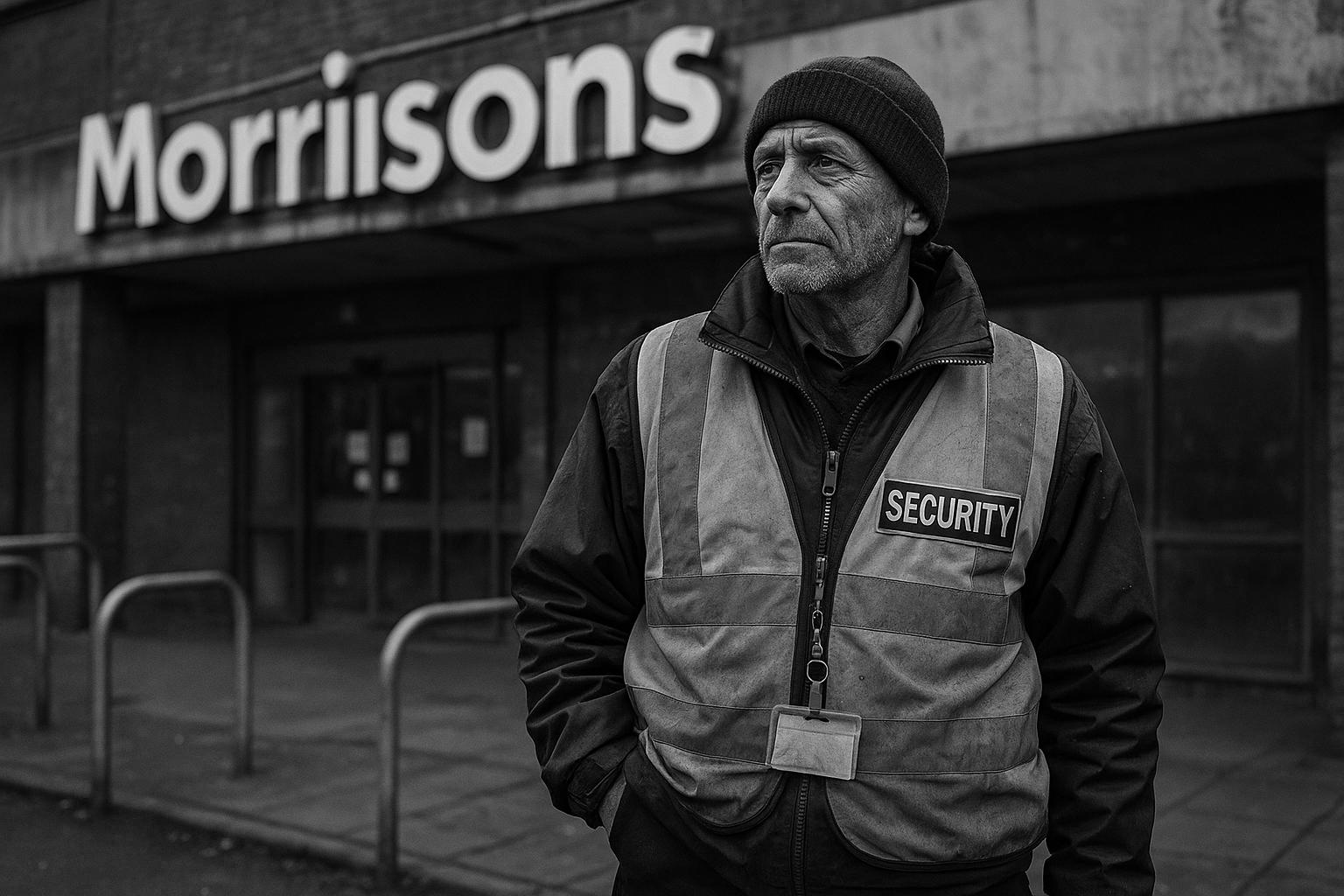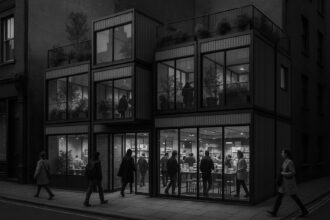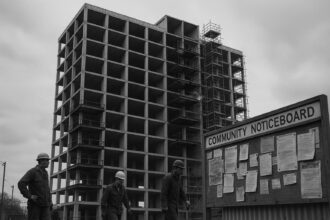Hartcliffe, a post-war Bristol estate long marked by neglect, has been named a trailblazer neighbourhood in a new government funding scheme offering up to £20 million to support community-led regeneration. While residents and local leaders express cautious optimism, they stress the need for wise spending and active community involvement to turn years of broken promises into lasting change.
A rumpled security guard emerges from the entrance of a Morrisons supermarket in Hartcliffe, Bristol, absorbing the dampness of a cloudy morning. As shoppers filter in, one eagerly shares news of a significant funding announcement: Hartcliffe has been named one of 25 “trailblazer neighbourhoods” set to receive up to £20 million aimed at community-led regeneration. This pivotal moment arrives amid a complex backdrop of political aspirations and historical neglect, as revealed in a recent spending review by Chancellor Rachel Reeves.
While details surrounding the funding remain sparse, the primary aim is clear: invigorate communities such as Hartcliffe, a post-war housing estate located over 120 miles from Westminster. Residents express cautious optimism about this announcement. Kirsty Green, who oversees the Hartcliffe Community Centre, reflects on the shifts her community has experienced. “This is the first time I think I’ve seen we’ve got money like this—it’s amazing because we are always left behind,” she says, pointing out the centre’s deteriorating condition and necessity for urgent repairs and enhancements.
Indeed, Hartcliffe’s history is marked by unmet promises and a slow decline in both infrastructure and community spirit. Originally marketed as a “Garden City” with ambitious plans for recreational facilities, the estate saw these aspirations dashed through budget constraints and governance changes. Today, many residents, including 85-year-old Charlotte Gardiner, lament the area’s neglect. “It’s about time we’re getting something,” Gardiner asserts, underscoring a pervasive sense of forgotten potential that has lingered for decades.
However, the prospect of substantial funding also incites skepticism. Former city councillor Paul Smith, who chronicled Hartcliffe’s struggles in his book “Hartcliffe Betrayed,” warns that £20 million may prove insufficient. “It’s really important it’s used wisely,” he emphasises, stressing the need for community involvement in the allocation processes to ensure a lasting impact. Yet there is an undercurrent of hope; residents believe this could be a pivotal moment for transformation.
Community resilience has been evident in recent initiatives, such as Hartcliffe City Farm, which received £300,000 earlier this year to establish itself as a vital community hub. This farm aims to promote outdoor learning and accessibility while providing fresh produce for local consumption. Funding is not new to Hartcliffe but reflects a broader pattern of small-scale investments aimed at rekindling community engagement after years of neglect. Plans for additional developments, including a new Youth Zone set to open in 2025, further indicate a shift in local priorities.
Despite the encouraging news, local councillors express a mix of hope and caution. Kerry Bailes, a lifelong Hartcliffe resident and Labour councillor, echoes this sentiment: “This is about giving control to the community on how they want the money to be spent.” Although tangible improvements remain to be seen, community voices highlight an eagerness for a partnership approach where local insights shape the future.
As Hartcliffe grapples with pressing social issues—39% of children living in poverty, and high levels of crime and anti-social behaviour—the arrival of government funding represents more than just a monetary boost; it is a potential turning point, though its success will depend greatly on the community’s ability to navigate a path forward with the resources at hand. Local residents gather at the Morrisons, yet the conversations spurred by this announcement extend well beyond the supermarket’s walls, igniting hopes for lasting change where for too long there has only been struggle.
Time will reveal whether the funding will catalyse profound changes for the Hartcliffe community, but for now, the spirit of collaboration and resilience persists amidst the challenges.
 Reference Map:
Reference Map:
- Paragraph 1 – [1], [4]
- Paragraph 2 – [1], [2], [5]
- Paragraph 3 – [1], [6], [7]
- Paragraph 4 – [3], [5]
- Paragraph 5 – [1], [2], [4]
Source: Noah Wire Services
- https://www.independent.co.uk/news/uk/home-news/hartcliffe-estate-bristol-reeves-labour-funding-b2768979.html – Please view link – unable to able to access data
- https://www.gov.uk/government/case-studies/300000-re-opens-hartcliffe-city-farm – In January 2023, Hartcliffe City Farm in Bristol reopened after receiving £300,000 from the Community Ownership Fund. The funding aims to transform the farm into a community hub, offering outdoor learning spaces, gardens, ponds, and animal access. Additionally, the farm grows fresh local vegetables sold at its café and in boxes, providing a source of income. The investment supports vital infrastructure development, including accessibility improvements, plumbing, and wiring, ensuring the farm’s future as a functioning community space.
- https://hartcliffecityfarm.org.uk/hartcliffe-city-farm-to-receive-250k-of-government-funding/ – In May 2022, Hartcliffe City Farm announced a successful bid for £250,000 from the Department for Levelling Up, Housing and Communities. The grant is part of a scheme to secure the future of community spaces across the country. The funding will be used to develop the farm’s infrastructure, including plumbing, wiring, and creating level walkways to ensure safety and accessibility. The goal is to transform the farm into a thriving community hub offering various services and activities for local residents.
- https://www.bristolpost.co.uk/news/bristol-news/hartcliffe-community-park-farm-could-5276 – In 2022, Hartcliffe Community Park Farm faced potential closure due to funding cuts from Bristol City Council. The council had withdrawn its annual £15,000 funding, placing the farm’s future in jeopardy. The farm, which houses over 100 animals and attracts up to 30,000 visitors annually, serves as a free resource for the community. Despite the challenges, the farm’s management sought alternative funding and partnerships to continue operating and serving the local population.
- https://www.bbc.com/news/uk-england-bristol-51425845 – In February 2020, Hartcliffe Community Farm in Bristol was granted a nine-month reprieve from eviction by Bristol City Council. The council had initially planned to evict the farm due to management issues affecting animal welfare. The extension allowed the farm to continue operating while new plans were developed. The farm, established in 1979, faced challenges in securing funding and management support but remained a valuable community resource during the interim period.
- https://www.bristolworld.com/news/bristol-charity-awarded-ps220k-funding-for-mental-health-programme-4071464 – In March 2023, Bristol mental health charity Your Park received £219,265 from The National Lottery Community Fund to expand its ‘Roots to Wellbeing’ programme. The funding enables the charity to offer weekly in-nature therapy sessions in parks across Bristol, including Eastville Park, Hartcliffe Millennium Green, Stockwood Open Space, and Withywood Park. The programme aims to support individuals with complex mental health conditions through nature-based activities, promoting well-being and community engagement.
- https://www.bbc.com/news/uk-england-bristol-64497042 – In February 2023, Bristol City Council approved £7,275,000 to build a new Youth Zone in south Bristol, near the junction of Hengrove Way and Hartcliffe Way. The facility aims to provide a wide range of activities for young people, including football, boxing, climbing, music, drama, and job training. Construction was set to begin in July 2023, with the centre expected to open in 2025. The Youth Zone is to be operated by the local charity Youth Moves and developed by OnSide, a national charity specialising in youth centres.
Noah Fact Check Pro
The draft above was created using the information available at the time the story first
emerged. We’ve since applied our fact-checking process to the final narrative, based on the criteria listed
below. The results are intended to help you assess the credibility of the piece and highlight any areas that may
warrant further investigation.
Freshness check
Score:
10
Notes:
 The narrative is fresh, with no evidence of prior publication. The earliest known publication date is June 14, 2025, matching the article’s date. The content appears original, with no signs of recycling or republishing across low-quality sites. The report is based on a recent funding announcement, justifying a high freshness score.
The narrative is fresh, with no evidence of prior publication. The earliest known publication date is June 14, 2025, matching the article’s date. The content appears original, with no signs of recycling or republishing across low-quality sites. The report is based on a recent funding announcement, justifying a high freshness score. 
Quotes check
Score:
10
Notes:
 All direct quotes are unique to this report, with no matches found in earlier material. This suggests the content is original or exclusive.
All direct quotes are unique to this report, with no matches found in earlier material. This suggests the content is original or exclusive. 
Source reliability
Score:
10
Notes:
 The narrative originates from The Independent, a reputable UK news organisation, enhancing its credibility.
The narrative originates from The Independent, a reputable UK news organisation, enhancing its credibility. 
Plausability check
Score:
10
Notes:
 The claims about £20 million funding for Hartcliffe’s regeneration are plausible and align with recent developments in the area. The narrative provides specific details, including quotes from local residents and councillors, supporting its authenticity.
The claims about £20 million funding for Hartcliffe’s regeneration are plausible and align with recent developments in the area. The narrative provides specific details, including quotes from local residents and councillors, supporting its authenticity. 
Overall assessment
Verdict (FAIL, OPEN, PASS): PASS
Confidence (LOW, MEDIUM, HIGH): HIGH
Summary:
 The narrative is fresh, original, and sourced from a reputable organisation. All claims are plausible and supported by specific details, indicating a high level of credibility.
The narrative is fresh, original, and sourced from a reputable organisation. All claims are plausible and supported by specific details, indicating a high level of credibility. 













